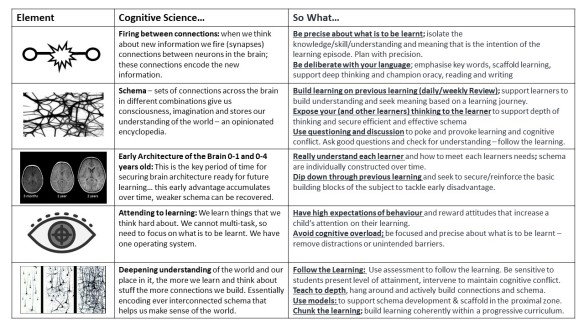Empowering Learning | Autumn Conference 2018
The key focus of the CLF Autumn Conference is empowering learning. This is the central aspect of the CLF improvement triangle that identifies three key aspects: 3-19 Curriculum (evolved by experts), 3-19 Pedagogy (delivered by experts) and 3-19 Assessment (used by experts).
The focus on CLF 3-19 Pedagogy will identify two key aspects:
- The CLF Cognitive Science: the cognitive basis for how we learn; so that teaching, pedagogy and learning has a sound scientific basis.
- The CLF Teaching Framework: the framework that provides for structure and language for experts to discuss teaching, pedagogy and learning.
The Conference is facilitating experts to discuss teaching and pedagogy against the background of cognitive science. Investigating the…
“… conversations and interactions that occur around events of interest between trusted and skilled adults and their child companions are especially powerful environments for learning.”
The Conference seeks to empower experts to discuss teaching and how we play with pedagogy to secure learning against the background of cognitive science and within the structure of the CLF Teaching Framework; concentrating on the key aspects that affect learning…
“Supportive learning environments, which are the social and organisational structures within which teachers and learners operate, need to concentrate on the key aspects that affect learning.”
CLF definition of learning

Teaching enables…
… children to acquire Knowledge & Skills, which secured through Application develops Understanding and allows the seeking of Meaning to achieve Personal growth
CLF Cognitive Science
Humans are amazing, the cognitive revolution that occurred 70,000 years ago placed them at the top of the food chain. At this point we developed an architecture of connections in the brain that allowed humans to think, invent and build meaning. In fact it is amazing what our 100 Billion neurons can encode…
“While a bee brain has one million neurons, a human one has one hundred billion, … we’re privileged in another way too: not only in the quantity, but the organisation of those neurons. Specifically, we have more brain cells between sensation (what’s out there?) and action (this is what I’m going to do). This allows us to take in a situation, chew on it, think through alternatives, and (if necessary) take action. The majority of our lives take place in the neural neighbourhoods between sensing and doing . This is what allows us to move from the reflexive to the inventive.” (Brandt and Eagleman, 2017)
From birth we are constantly trying to make sense of the world…

Babies are born with a biological capacity to learn; this raw capacity is actualised by the surrounding environment. From birth they are constantly striving to make sense of their environment so they can gauge where best to invest their attention.
Understanding how we learn through the key principles of cognitive science (that have become much clearer over the last 15 years) allow us greater insight into the mechanics and impact of teaching. It provides a basis on which we can play with pedagogy and drive learning and secure progress over time. The table below highlights the CLF Cognitive Science approach (20 principles) that underpins the CLF Teaching Framework.

The following table identifies the five key cornerstones of cognitive science that explains how we learn. The Cognitive Science column defines the principle and the “So What” column seeks to identify what this means for learning and teaching…
The next five seek to explore short and long term memory, myelin, curve of forgetting and automation…

The next 5 consider schema and proximal zones, and what this means for disadvantage and different levels of attainment…

The final five consider the curriculum, co-construction, the role of emotion, cognitive overload and our ability for divergent thinking…

“The genius of our human minds is that they are endlessly adaptable and more powerful than we realise… learning is our superpower..” (Alex Beard, 2018)
CLF Teaching Framework
Based on the CLF Cognitive Science, CLF Pedagogy Developers have developed a CLF Teaching Framework that seeks the support the discussion and development of Teaching and Pedagogy across the Trust.
This is based on considering learning through an I DO, WE DO and YOU DO lens, so that we follow the learning and meet needs of all children. This seeks to secure learning within a culture that supports learners to attend to their learning.
The framework is detailed in the following diagram…

The Conference supports experts to consider each of the aspect of the CLF Teaching Framework against the Cognitive Science background. The diagram below highlights the I DO and Pre DO aspects of the Teaching Framework and how this might link to the Cognitive Science…

The diagram below highlights the WE DO and Follow the Learning aspects of the Teaching Framework and how this might link to the Cognitive Science…

The diagram below highlights the YOU DO and Climate/Culture aspects of the Teaching Framework and how this might link to the Cognitive Science…

An unswerving focus on learning and how this supports children to learn, seek meaning and find their way in the world is a privilege; education is the premise of progress…
“Knowledge is power. Information is liberating. Education is the premise of progress, in every society, in every family” (Kofi Annan)
Dan Nicholls
CLF Conference 2018
Cabot Learning Federation | October 2018

